
The Central Tibetan Administration is the Tibetan government in exile based in Dharamshala, India. It is composed of a judiciary branch, a legislative branch, and an executive branch.

Dharamshala is a town in the Indian state of Himachal Pradesh. It serves as the winter capital of the state and the administrative headquarters of the Kangra district since 1855. The town also hosts the Tibetan Government-in-exile. Dharamshala was a municipal council until 2015, when it was upgraded to a municipal corporation.
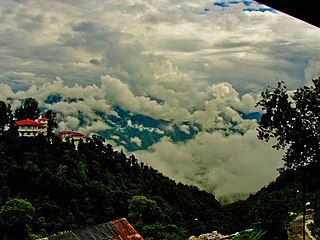
Mussoorie is a hill station and a municipal board, in Dehradun city in the Dehradun district of the Indian state Uttarakhand. It is about 35 kilometres (22 mi) from the state capital of Dehradun and 290 km (180 mi) north of the national capital of New Delhi. The hill station is in the foothills of the Garhwal Himalayan range. The adjoining town of Landour, which includes a military cantonment, is considered part of "greater Mussoorie", as are the townships Barlowganj and Jharipani.

Namgyal Monastery is currently located in Mcleod Ganj, Dharamsala, India. It is the personal monastery of the 14th Dalai Lama. Another name for this temple-complex is Namgyal Tantric College.
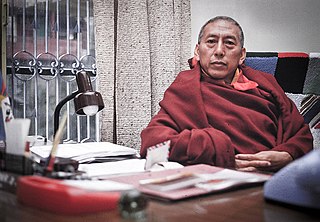
Lobsang Tenzin, better known by the titles Professor Venerable Samdhong Rinpoche and to Tibetans as the 5th Samdhong Rinpoche, is a Tibetan Buddhist monk and politician who served as the Prime Minister of the cabinet of the Central Tibetan Administration, the Tibetan government-in-exile based in Dharamshala, India.

Tibetan Children's Villages or TCV is an integrated community in exile for the care and education of orphans, destitutes and refugee children from Tibet. It is a registered, nonprofit charitable organization with its main facility based at Dharamsala in Himachal Pradesh, North India. TCV has a network spread across India with over 12,000 children under its care.

The Central Institute of Higher Tibetan Studies, formerly called Central University for Tibetan Studies (CUTS), is a Deemed University founded in Sarnath, Varanasi, India, in 1967, as an autonomous organisation under Union Ministry of Culture. The CIHTS was founded by Pt. Jawahar Lal Nehru in consultation with Tenzin Gyatso, the 14th Dalai Lama, with the aim of educating Tibetan youths in exile and Himalayan border students as well as with the aim of retranslating lost Indo-Buddhist Sanskrit texts that now existed only in Tibetan, into Sanskrit, to Hindi, and other modern Indian languages.

Tempa Tsering.
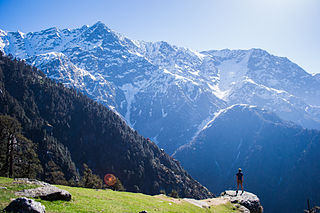
McLeod Ganj or McLeodganj is a suburb of Dharamshala in Kangra district, Himachal Pradesh, India. It is known as "Little Lhasa" or "Dhasa" as the Tibetan government-in-exile is headquartered here and there is a significant population of Tibetans in the region.
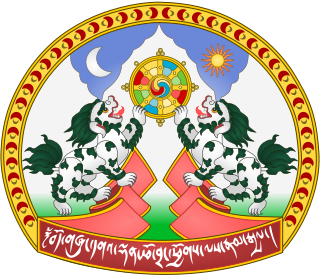
The Sikyong is the political leader of the Central Tibetan Administration, a Tibetan exile organisation in India also known as the Tibetan Government-in-Exile based on the 2011 Charter of Tibetans-in-exile. The title was created in 2012 after the 14th Dalai Lama decided not to assume any political and administrative authority as the head of the Tibetan Administration for Tibetans-in-exile.

The 14th Dalai Lama is, as the incumbent Dalai Lama, the highest spiritual leader and head of Tibetan Buddhism. By the adherents of Tibetan Buddhism, he is considered a living Bodhisattva; specifically, an emanation of Avalokiteśvara in Sanskrit, and Chenrezig in Tibetan. He is also the leader and a monk of the Gelug school, the newest school of Tibetan Buddhism, formally headed by the Ganden Tripa. The central government of Tibet at the time of his selection, the Ganden Phodrang, invested the Dalai Lama with temporal duties until his exile in 1959.
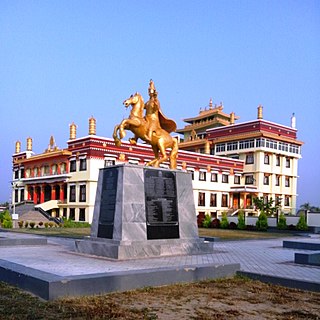
The Tibetan diaspora are the diaspora of Tibetan people living outside Tibet.

Buddhism in the Himachal Pradesh state of India of has been a long-recorded practice. The spread of Buddhism in the region has occurred intermediately throughout its history. Starting in the 3rd century BCE, Buddhism was propagated by the Maurya Empire under the reign of Ashoka. The region would remain an important center for Buddhism under the Kushan Empire and its vassals. Over the centuries the following of Buddhism has greatly fluctuated. Yet by experiencing revivals and migrations, Buddhism continued to be rooted in the region, particularly in the Lahaul, Spiti and Kinnaur valleys.
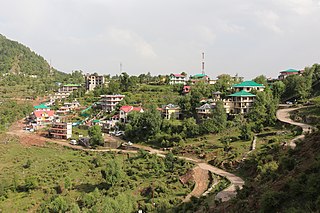
Naddi is a village in the Indian state of Himachal Pradesh. It is located at an altitude of 2000 meters above sea level, in the upper reaches of the Kangra valley. The village is situated about 3 kilometers from Mc Leod Ganj, known worldwide for the presence of the Dalai Lama. On 29 April 1959, the 14th Dalai Lama established the Tibetan exile administration in the north Indian hill station of Mussoorie. In May 1960, the Central Tibetan Administration (CTA) was moved to Dharamshala.

Lhasang Tsering is a Tibetan poet, writer, and activist. He was President of the Tibetan Youth Congress and a founding director of Amnye Machen Institute in Dharamshala, India. He is a vociferous and ardent advocate of Tibet's independence and a passionate lover of literature.
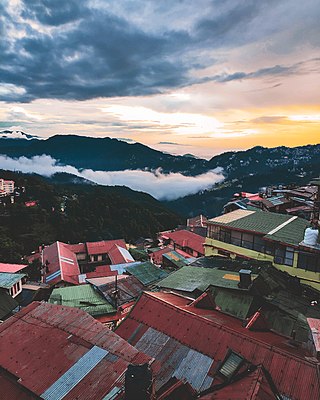
Tourism in Himachal Pradesh relates to tourism in the Indian state of Himachal Pradesh. This is popularly renowned for its Himalayan landscapes and popular hill-stations. Many outdoor activities such as rock climbing, mountain biking, paragliding, ice-skating, trekking, rafting, and heli-skiing are popular tourist attractions in Himachal Pradesh.

Yeshi Dhonden was a Tibetan doctor of traditional Tibetan medicine, and served the 14th Dalai Lama from 1961 to 1980. In 2018, the Indian government honoured him with the Padma Shri, the fourth highest civilian award in India.

Tibet–India relations are said to have begun during the spread of Buddhism to Tibet from India during the 6th century AD. In 1959, the Dalai Lama fled to India after the failed 1959 Tibetan uprising. Since then, Tibetans-in-exile have been given asylum in India, with the Indian government accommodating them into 45 residential settlements across 10 states in the country, creating the Tibetan diaspora. From around 150,000 Tibetan refugees in 2011, the number fell to 85,000 in 2018, according to government data. Many Tibetans are now leaving India to go back to Tibet and other countries such as United States or Germany. The Government of India, soon after India's independence in 1947, treated Tibet as a de facto independent country. However, more recently India's policy on Tibet has been mindful of Chinese sensibilities, and has recognized Tibet as a part of China.

Geshe Lhakdor Tibetan: དགེ་བཤེས་ལྷག་རྡོར, Wylie: dge bshes lhag rdor, also Geshe Lobsang Jordhen and Geshe Lhakdor Lobsang Jordan Tibetan: བློ་བཟང་འབྱོར་ལྡན, Wylie: blo bzang 'byor ldan, is a Tibetan Buddhist scholar who has co-authored and co-translated several books on Tibetan Buddhism. He was also an English translator of the 14th Dalai Lama. He is a Director of the Library of Tibetan Works and Archives in Dharamshala, India. He is also an Honorary Professor at the University of British Columbia, Canada.





















